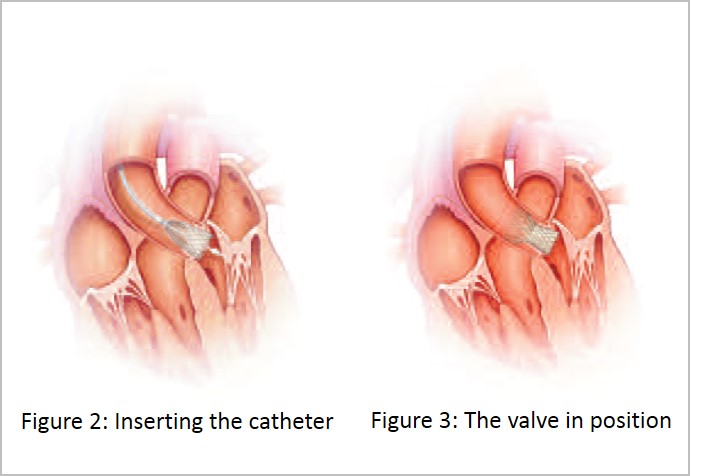A TAVI (transcatheter aortic valve implantation), is a valve which is fitted in the heart to treat a condition called aortic stenosis. Made from the natural tissue of a cow or pig's heart, the new valve is fitted on top of the old, damaged valve. Your doctor will talk to you about the best type of valve for you.
A TAVI takes one to two hours, and is usually carried out under a local anaesthetic (you are awake but you do not feel pain), although it can also be carried out under a general anaesthetic, depending on what's best for you. Again, your doctor will talk this through with you.
Most people come into hospital the day before their operation, or on the day of their TAVI, and stay for between two to five days.
How a TAVI is done
Doctors will make a small cut (incision) in your groin, or the top of your shoulder, although other routes are sometimes used.
Small tubes, called catheters, are then inserted into the artery and vein at the site of the incision. These tubes help doctors see where to put the new valve and give them access to the heart. The tubes also provide a safe way for the doctors to administer drugs during the procedure or allow a temporary pacemaker to be fitted, if needed. Your new valve is put into a catheter before the doctor guides it the it through the artery to your damaged aortic valve (Fig. 2). From there, the new valve (Fig. 3) is stitched to a stent (a small metal mesh tube), to hold it in place.
Your doctor will check that the new valve is working well before removing the catheter and closing the cut in your groin, chest or shoulder.
The new valve and stent will stay in place for the rest of your life.

Find out more about how to look after yourself before and after the TAVI procedure.
Aortic stenosis is the narrowing of the aortic valve, which controls the flow of blood in and out of the heart.
Alternative treatments
Before deciding whether to have a TAVI, you can speak to a doctor or nurse about alternative treatments which may be available to you. These include:
- Aortic valve replacement
Aortic valve replacement is an open heart surgical treatment for aortic stenosis. It is an effective, life-saving option for many people, but it isn't suitable for everyone - Balloon valvuloplasty (BAV)
A BAV can temporarily open up the narrowed valve. In a BAV, a catheter with a balloon on the tip is guided to the diseased aortic valve and inflated in order to open up the valve. A BAV is not a long-term solution because the valve can become narrowed again - Medication
Medication may be able to control your symptoms, but it can't treat the narrowing of the aortic valve - Palliative treatment
Sometimes a TAVI and alternative treatments are not suitable, or you may decide not to have treatment. In this case, your doctor may refer you to the palliative care team to help you manage your symptoms and maintain a good quality of life.
If you would like to discuss your TAVI procedure with someone, find out more.
Useful contacts
Harefield Hospital
- TAVI clinical nurse specialist: 01895 823 737 ext. 85023
- Parkwood House visitor accommodation: 01895 828 823
- Outpatients: 01895 828 695
Royal Brompton Hospital
- TAVI department: 020 7351 8121 ext. 82398
- TAVI clinical nurse specialist: 020 7351 8110 or 0207 351 8371 and ask for bleep 1194
- South Parade visitor accommodation: 020 7351 8044
- Outpatients: 020 7351 8011
